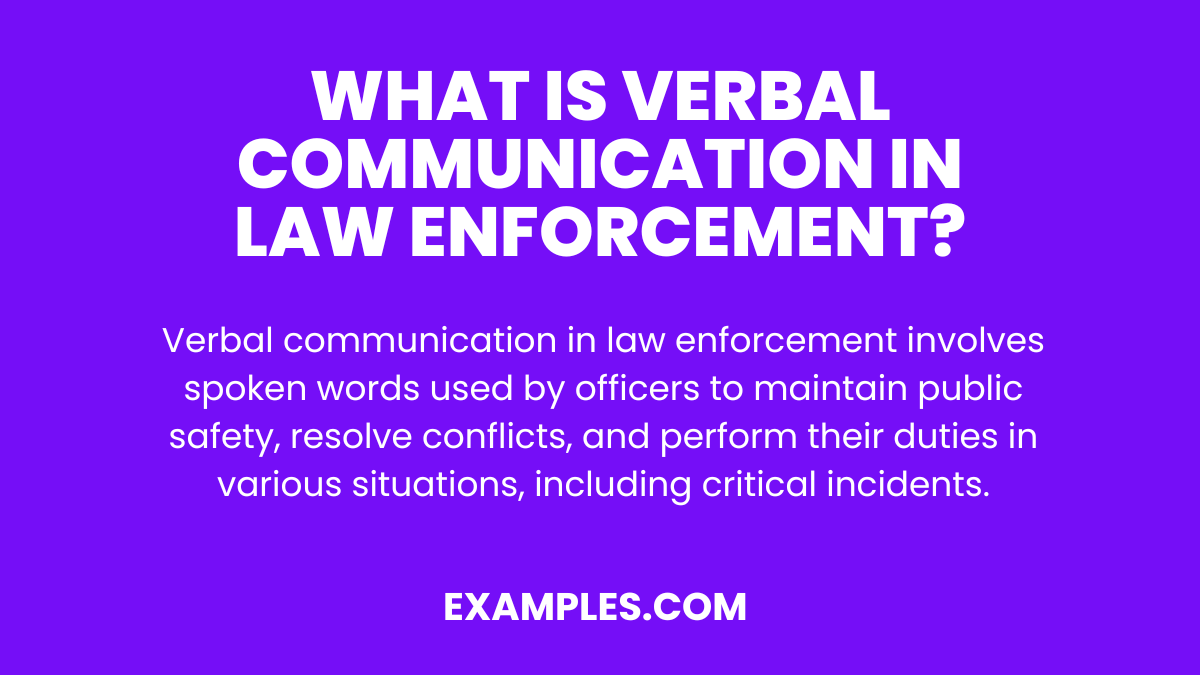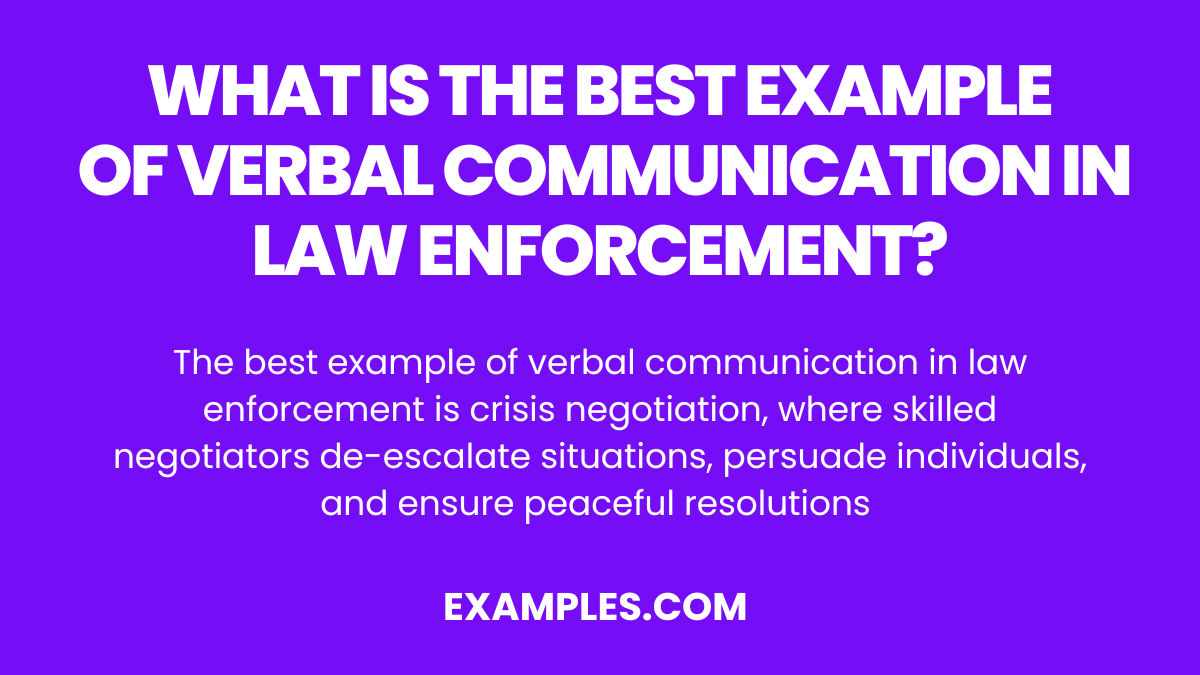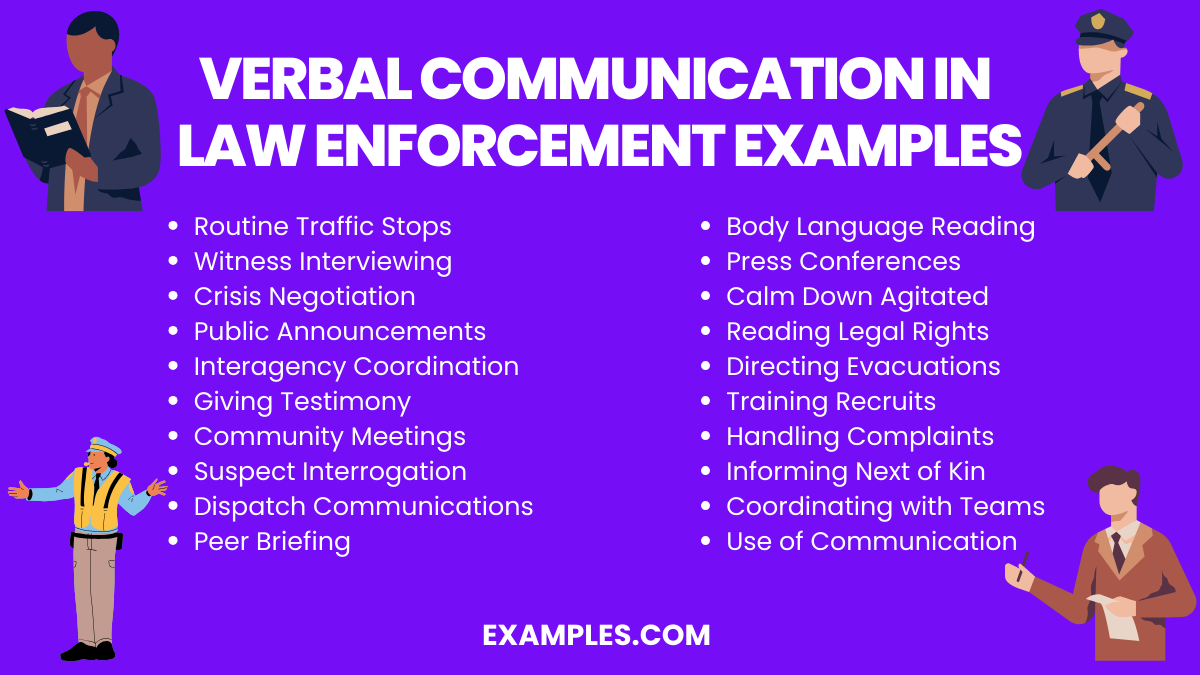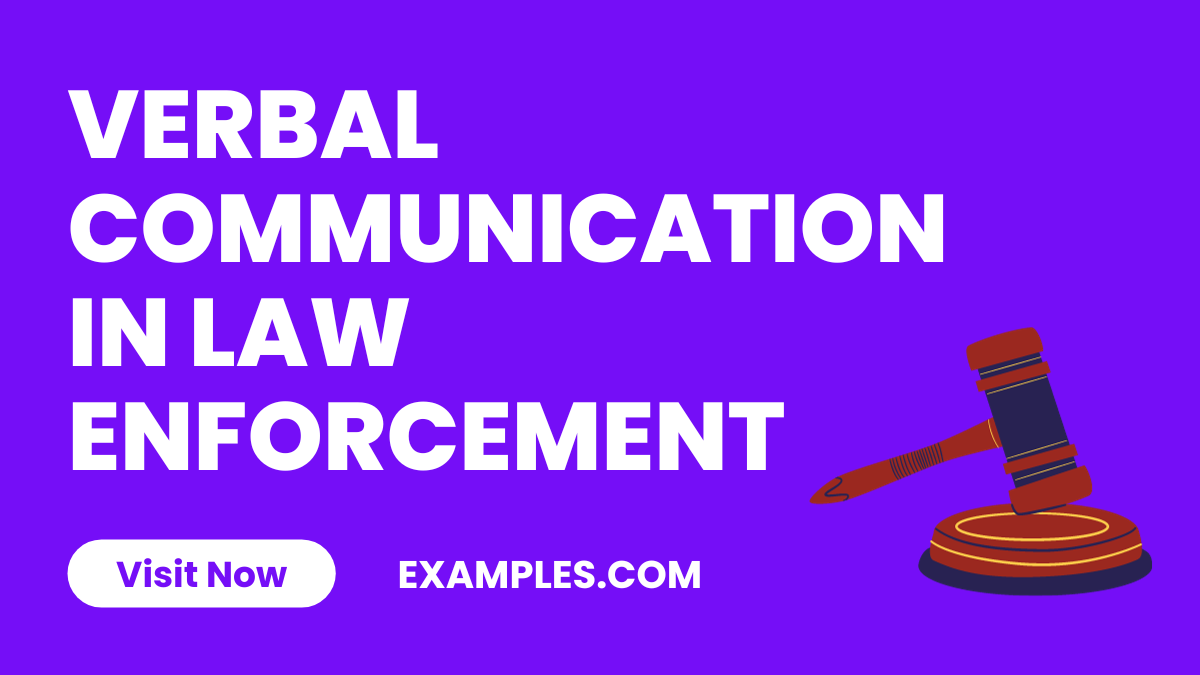Verbal Communication in Law Enforcement – Examples, How to Develop
Delve into the critical world of law enforcement where every word counts. This guide provides a comprehensive overview of Verbal Communication in Law Enforcement, enriched with practical Communication Examples. From routine patrols to high-stakes negotiations, understand how effective communication strategies can de-escalate conflicts, build community trust, and save lives. Discover the techniques that empower officers to handle various situations with clarity and confidence.
What is Verbal Communication in Law Enforcement? – Meaning

Verbal communication in law enforcement refers to the spoken words used by police and other law enforcement personnel to effectively perform their duties. It encompasses a range of interactions, from conversing with the community to negotiating in critical incidents. Clear and effective verbal communication is vital for ensuring public safety, resolving conflicts, and maintaining order. It’s a skill that requires constant refinement and understanding of both tactical communication and the power of words in high-pressure situations.
What is the Best Example of Verbal Communication in Law Enforcement?

The best example of verbal communication in law enforcement is often seen during crisis negotiation scenarios. Here, skilled negotiators use their words carefully to de-escalate tense situations, persuade individuals to desist from harmful actions, and ensure a peaceful resolution. They employ active listening, empathy, and strategic speaking to connect with the subject, understand their demands, and guide them towards a safe outcome. This high-stakes communication showcases the profound impact and critical importance of verbal skills in law enforcement operations.
20 Verbal Communication in Law Enforcement Examples

Embark on a comprehensive exploration of verbal communication within the realm of law enforcement. This detailed guide highlights 20 distinct Verbal Communication Examples pivotal for police and law enforcement officials. Discover the intricate balance of What Percent of Communication is Verbal? and the impact of effective Verbal Communication Techniques. Learn the Advantages and Disadvantages of Verbal Communication, along with the core Functions of Verbal Communication that are critical in high-pressure situations. Understand the various Types of Verbal Communication, essential Verbal Communication Skills, and the contrasts between Verbal vs Written Communication. Lastly, delve into Ways to Improve Verbal Communication Skills for law enforcement effectiveness.
- Routine Traffic Stops: Clear communication of intentions and requests.
Cause: Ensuring compliance and safety. Fix: Use authoritative yet calm tone. - Witness Interviewing: Gathering accurate and detailed information.
Cause: Need for clear facts. Fix: Use open-ended questions and active listening. - Crisis Negotiation: De-escalating high-stress situations.
Cause: Resolving conflicts safely. Fix: Employ empathy and tactical communication strategies. - Public Announcements: Providing clear instructions during emergencies.
Cause: Informing and directing the public. Fix: Use simple, direct language and repeat key information. - Interagency Coordination: Collaborating with other law enforcement bodies.
Cause: Need for coordinated response. Fix: Use clear, professional jargon and confirm understanding. - Giving Testimony: Communicating facts in court.
Cause: Legal proceedings. Fix: Practice clear, concise, and truthful articulation. - Community Meetings: Engaging with residents to build trust.
Cause: Community policing. Fix: Use friendly, open, and inclusive language. - Suspect Interrogation: Eliciting truthful information from suspects.
Cause: Investigation requirement. Fix: Employ strategic questioning and psychological tactics. - Dispatch Communications: Coordinating rapid response and information.
Cause: Operational efficiency. Fix: Use clear codes and confirm receipt of messages. - Peer Briefing: Sharing critical information with colleagues.
Cause: Team awareness. Fix: Be concise, clear, and ensure understanding. - Body Language Reading: Complementing verbal with nonverbal cues.
Cause: Enhancing situational awareness. Fix: Train in body language interpretation. - Press Conferences: Relaying information to the public and media.
Cause: Public relations. Fix: Prepare key messages and practice delivery. - Calm Down Agitated Individuals: Using de-escalation tactics.
Cause: Prevent escalation. Fix: Maintain composure and use soothing language. - Reading Legal Rights: Informing individuals of their rights.
Cause: Legal requirement. Fix: Use clear, unambiguous language. - Directing Evacuations: Guiding public during emergencies.
Cause: Safety management. Fix: Use loud, clear instructions and repeat as necessary. - Training Recruits: Educating new officers.
Cause: Knowledge transfer. Fix: Use interactive, clear, and supportive communication. - Handling Complaints: Addressing public grievances.
Cause: Community service. Fix: Listen actively and respond empathetically. - Informing Next of Kin: Delivering sensitive news.
Cause: Duty to inform. Fix: Use compassionate, clear, and respectful language. - Coordinating with Medical Teams: Collaborating at accident scenes.
Cause: Emergency response. Fix: Use clear, medical terminology where appropriate. - Use of Communication Devices: Ensuring clarity over radios.
Cause: Technological communication. Fix: Speak slowly, clearly, and use protocol.
Verbal Communication in Law Enforcement at Workplace
In the high-stakes environment of law enforcement, effective Verbal Communication in the Workplace is crucial. It ensures not only the safety and efficiency of operations but also the well-being of officers and the public. This guide highlights how Verbal Communication in Law Enforcement is practiced within the workplace, focusing on clarity, command, and compassion as key aspects. Discover strategies that officers use daily to maintain order, ensure safety, and build community trust.
- Daily Roll Call Briefings: Conveying day’s objectives and alerts. “Today’s focus is on traffic safety—let’s be vigilant.”
- Radio Dispatch Communication: Efficiently coordinating responses. “We have a 10-50 on Main Street, need immediate backup.”
- Debriefing Sessions: Sharing insights post-incident. “Let’s discuss what went well and what can be improved.”
- Interdepartmental Meetings: Aligning on strategies and protocols. “Our joint task force will focus on community hotspots.”
- Safety Announcements: Alerting colleagues to hazards or updates. “Reminder: New traffic reroute affects our patrol routes.”
Verbal Communication in Law Enforcement for Employees
Verbal Communication for Employees in law enforcement goes beyond the typical office dialogue. It’s about creating an environment of respect, efficiency, and continuous learning. Officers rely on clear communication to relay information, educate each other, and debrief after critical incidents, ensuring that Verbal Communication in Law Enforcement is always evolving and adapting. This section provides insights into how verbal skills are essential not just for duty calls but for fostering a supportive and knowledgeable workforce.
- Policy Updates: Informing about new regulations or procedures. “Please review the updated pursuit policy by end of week.”
- Training and Development: Enhancing skills through instruction. “This training will cover the latest de-escalation techniques.”
- Performance Feedback: Offering constructive criticism and praise. “Your handling of the situation was commendable, particularly…”
- Mental Health Resources: Discussing available support. “If you or someone you know needs support, here’s how to access our services.”
- Recognition and Awards: Acknowledging exemplary work. “Officer Smith will be recognized for outstanding community service this month.”
How do Law Enforcement Officers Receive Training in Verbal Communication Skills?
Law enforcement officers receive training in verbal communication skills to effectively manage diverse situations they encounter daily. This training is crucial for ensuring the safety and effectiveness of their duties, emphasizing How to Improve Verbal Communication Skills for better community interactions and conflict resolution.
- Academy Training: Recruits learn the Verbal Communication for School, including tone, clarity, and command presence, through scenario-based training.
- Role-playing Exercises: Officers practice real-life situations, receiving feedback on their verbal strategies and approach.
- Crisis Negotiation Courses: Specialized training is provided for situations requiring advanced negotiation skills and empathy.
- Continual Professional Development: Officers attend workshops and seminars to stay updated on the latest communication techniques and public interaction strategies.
- Peer Review and Mentoring: Experienced officers mentor rookies, offering insights and advice on effective communication based on real-world experiences.
What is the Importance of Verbal Communication in Law Enforcement?
Verbal communication is a critical tool for law enforcement officers, directly impacting their ability to maintain public safety, resolve conflicts, and build community trust. Understanding Why you need Verbal Communication Skills and the Importance of Verbal Communication is fundamental in law enforcement training and practice.
- Building Trust with the Community: Effective communication Verbal Communication for Students to helps officers create a rapport with citizens, fostering cooperation and community support.
- De-escalating Conflicts: Skillful verbal interaction can defuse potentially volatile situations, avoiding escalation and violence.
- Gathering Information: Clear and strategic questioning enables officers to collect vital information during investigations or interactions.
- Providing Clear Instructions: During emergencies, the ability to convey instructions clearly can mean the difference between chaos and order.
- Protecting Officer Safety: Effective communication skills are crucial for officers to assert control and ensure their own safety and that of others in various situations.
How to Develop Effective Verbal Communication in Law Enforcement?
Developing effective verbal communication in law enforcement hinges on nurturing essential Communication Skills through comprehensive training programs. These programs should encompass active listening, de-escalation techniques, and conflict resolution tactics. Scenario-based training exercises can help officers practice these skills in realistic contexts, preparing them to handle high-stress situations with composure and professionalism. Cultural sensitivity and diversity training are equally vital, ensuring respectful interactions with individuals from various backgrounds. By prioritizing Law Enforcement Training that emphasizes effective communication, agencies can cultivate officers who not only maintain public safety but also build trust and positive relationships within the communities they serve.
How Does Effective Verbal Communication Benefit Law Enforcement officers?
Effective verbal communication enhances officer-community relations, de-escalates conflicts, and promotes trust, crucial for community policing. It fosters cooperation and understanding, aiding investigations.
What Role Does De-escalation Play in Law Enforcement Verbal Communication?
De-escalation is pivotal in diffusing tense situations. Officers use verbal skills to calm individuals, reduce risks, and minimize force usage, prioritizing safety and conflict resolution.
What strategies can be Implemented to Improve the Overall Effectiveness of Verbal Communication in Law Enforcement?
Implement rules of verbal communication, emphasizing active listening, clear language, empathy, and cultural sensitivity. Invest in ongoing training, scenario-based exercises, and technology for transparent, accountable interactions with the public.
In conclusion, effective verbal communication is paramount in law enforcement, distinct from mere oral communication. It yields positive effects such as trust-building, crisis de-escalation, and community cooperation. Recognizing signs of improvement, employing de-escalation techniques, and adhering to communication rules are essential fixes. By embracing the nuances of verbal vs. oral communication, law enforcement can enhance safety, transparency, and public relations, ultimately fostering a more secure and harmonious society.



